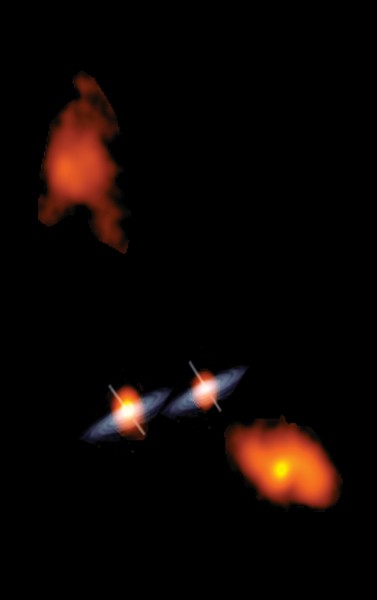NRAO
Binary black hole systems are rare enough, but the pair of supermassive black holes orbiting around each other at the center of the distant radio galaxy 0402+379 offer something even more anomalous. They're slow—really slow. Despite currently residing just 23 light-years apart, the smallest distance ever measured between binary black holes, the black holes move through space at just 1 micro-arcsecond per year, which is slow enough that astronomers predict the black holes eventual merger may never happen.These new observations come courtesy of a paper published this month in the Astrophysical Letters (a free version is still available at the arXiv preprint server) by radio astronomers at the University of New Mexico and Stanford University.Despite the close proximity, the black holes complete an orbit around each other only once every 30,000 years. To collect the requisite data, It took the astronomers 12 years of regular snapshots and a network of radio telescopes spread from the US Virgin Islands to New Mexico to Alaska. Putting that sludgy progress in even sharper relief is the sheer scale of the two black holes. Combined, they add up to the mass of about 15 billion suns, making them among the largest black holes ever recorded. "If you imagine a snail on the recently discovered Earth-like planet orbiting Proxima Centauri—a bit over four light years away—moving at one centimeter a second, that's the angular motion we're resolving here," offered Stanford's Roger Romani, a study co-author, in a statement. The angle represented by a single micro-arcsecond is about 1 billion times smaller than the smallest thing visible by the naked human eye.Saying this is the slowest motion ever recorded is actually kind of a fudge. This is the first time astronomers have directly measured the orbital motion of a black hole at all. The really interesting thing about the observations is the insight offered into the process of merging galaxies. This sluggish duo may represent what's called a "fossil cluster," an intermediate stage in the collision of two galaxies."For a long time, we've been looking into space to try and find a pair of these supermassive black holes orbiting as a result of two galaxies merging," added Greg Taylor, lead author of the new paper. "Even though we've theorized that this should be happening, nobody had ever seen it, until now."
"If you imagine a snail on the recently discovered Earth-like planet orbiting Proxima Centauri—a bit over four light years away—moving at one centimeter a second, that's the angular motion we're resolving here," offered Stanford's Roger Romani, a study co-author, in a statement. The angle represented by a single micro-arcsecond is about 1 billion times smaller than the smallest thing visible by the naked human eye.Saying this is the slowest motion ever recorded is actually kind of a fudge. This is the first time astronomers have directly measured the orbital motion of a black hole at all. The really interesting thing about the observations is the insight offered into the process of merging galaxies. This sluggish duo may represent what's called a "fossil cluster," an intermediate stage in the collision of two galaxies."For a long time, we've been looking into space to try and find a pair of these supermassive black holes orbiting as a result of two galaxies merging," added Greg Taylor, lead author of the new paper. "Even though we've theorized that this should be happening, nobody had ever seen it, until now."
Advertisement

